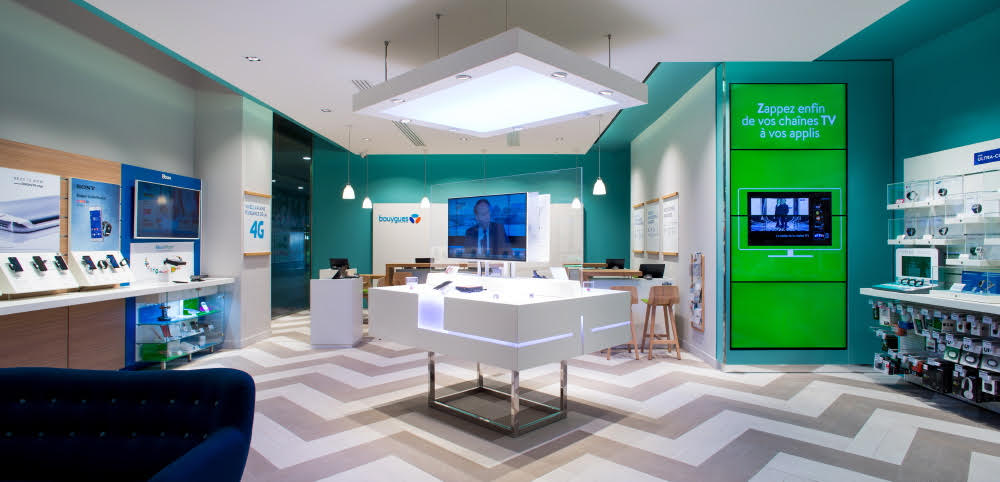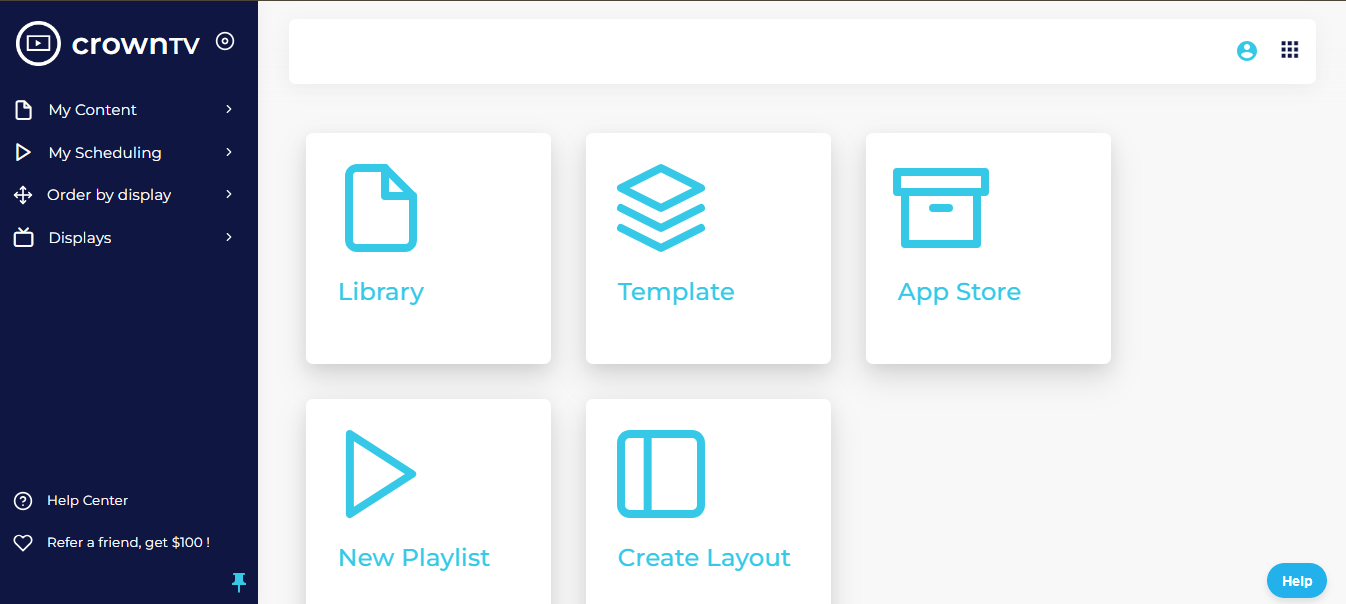Picture your most eye-catching advertisement. Is it a sleek video playing on a vibrant screen, or a faded poster taped to a window? Chances are, your mind went to the digital option. There’s a reason digital signage is all the rage – but does that mean traditional methods are dead? Let’s talk about digital signage vs traditional signage!
Let’s break it down. In this article, we’ll cover:
- Traditional signage: What it is, plus the pros and cons
- Digital signage: Definitions, benefits, and drawbacks
- The head-to-head battle: Which is right for your business
Get ready to weigh your options and make the smartest signage choice.
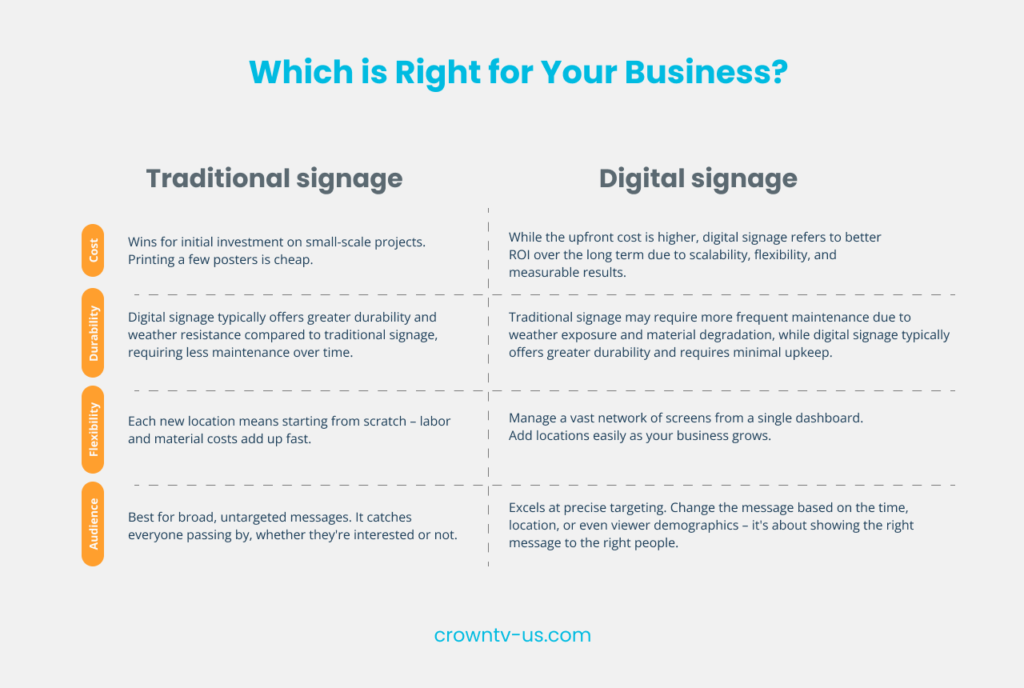
What Is Traditional Signage?
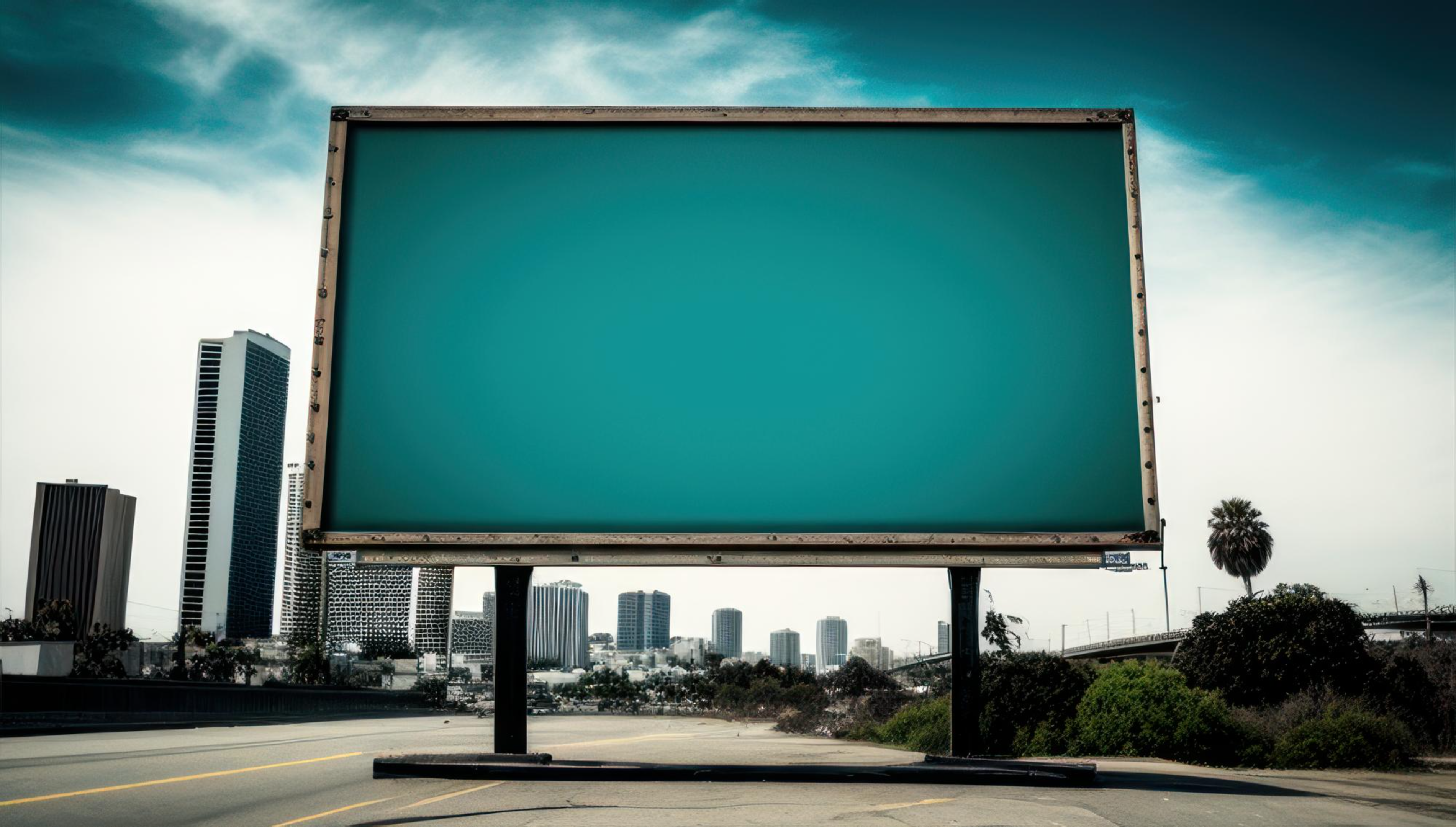
Think back to the last time you strolled through a mall or walked down a bustling street. You likely saw a mix of billboards, printed posters, banners, and maybe even a classic “sandwich board” advertisement on the sidewalk. These are all examples of traditional signage.
Traditional signage is any static (non-moving) form of advertising or information display. It relies on printed materials, paint, or other unchanging elements to get its message across. Here are some common types:
- Billboards: Those giant roadside advertisements. You can’t miss them towering over highways or lining city streets. Billboards typically use large, bold visuals and concise text to grab the attention of drivers and pedestrians alike.
- Posters and flyers: These versatile workhorses can be displayed almost anywhere. Posters are typically displayed on windows, walls, and bulletin boards, while flyers are handed out or placed in high-traffic areas. With the ability to make a flyer, businesses and individuals can create custom designs that suit their specific needs, whether promoting local events, advertising sales, or sharing important announcements.
- Banners: Bold, eye-catching banners are a great way to make a big statement. They’re often hung across streets between light posts or strung up at festivals and fairs. Banners can be made from a variety of materials, including vinyl, canvas, and mesh, and can be customized with any message or image.
- A-frame signs: These sidewalk classics, also known as sandwich boards, are a low-cost way to advertise your business to passersby. Typically made of wood or metal, A-frame signs have two hinged sides that display your message. They’re perfect for restaurants, cafes, shops, and any business with street visibility.
Traditional signage has been around for centuries, and for good reason. We’ll get into the pros and cons in a bit but understand that this tried-and-true method still has a place in the modern marketing world.
The Pros and Cons of Traditional Signage
Don’t write off those posters and billboards just yet. Despite the rise of digital tech, traditional signage offers some distinct advantages:
Pros of Traditional Signage
- Cost-effective (at least initially): Printing flyers or creating a simple A-frame sign can be surprisingly affordable. With a flyer maker tool, businesses can easily design professional-quality flyers without needing extensive design skills. This makes traditional signage a tempting option for small businesses with tight budgets.
- Simple and reliable: There are no screens to glitch, no software updates to mess with, and no internet connection required. Once up, a sign delivers your message without fuss. It’s especially useful if dealing with power outages or areas with unreliable service.
- Versatile placement: Want to target customers on a specific street? Easy, just hang up a banner. Posters, flyers, and signs can be placed strategically in highly visible locations without complex installation or permits.
- Builds familiarity: Think about the classic Coca-Cola billboards or those iconic, golden fast-food arches. Repeated exposure to traditional signage can etch a brand into consumers’ minds and build a sense of familiarity over time.
Pro Tip:In the world of real estate, a well-designed “For Sale” sign in front of a house is still a powerful signal – don’t discount the simple things.
The Cons of Traditional Signage
While traditional signage certainly has its place, it’s important to understand the limitations as well:
- Static and Unchanging: A printed poster can only show one message, and changing it involves reprinting and re-installation. This can make it slow to adapt to new campaigns or promotions.
- Limited Interactivity: Unlike their digital counterparts, traditional signs can’t interact with viewers. You miss out on the ability to collect data, measure engagement, or provide viewers with a more immersive, personalized experience.
- Susceptible to Wear & Tear: Sunlight, rain, and general wear can quickly degrade printed materials. Fading colors, ripped paper, or water-damaged displays give an unprofessional look. This can mean regular maintenance and replacement costs.
- Measuring Results is Tricky: While you might get a sense of a campaign’s success with traditional signage, pinpointing precise metrics, like the number of people who saw your ad, is hard compared to digital tools.
- Limited Targeting: Traditional signs reach everyone in the vicinity, regardless of demographics or interests. This can mean wasted impressions on people who aren’t potential customers.
- Environmentally Unfriendly: The printing and disposal of traditional signage materials can create a bigger environmental footprint compared to digital displays. Consider using recycled materials or finding ways to reuse signage whenever possible.
- Lack of Scalability: If you want to expand your campaign to new locations, you essentially have to start from scratch with traditional signage. Digital signage allows for easy scaling and remote management across multiple locations.
Important Note: The effectiveness of traditional signage heavily depends on design and placement. A poorly designed poster or a billboard in a low-visibility area won’t do your business any favors.
What is Digital Signage?
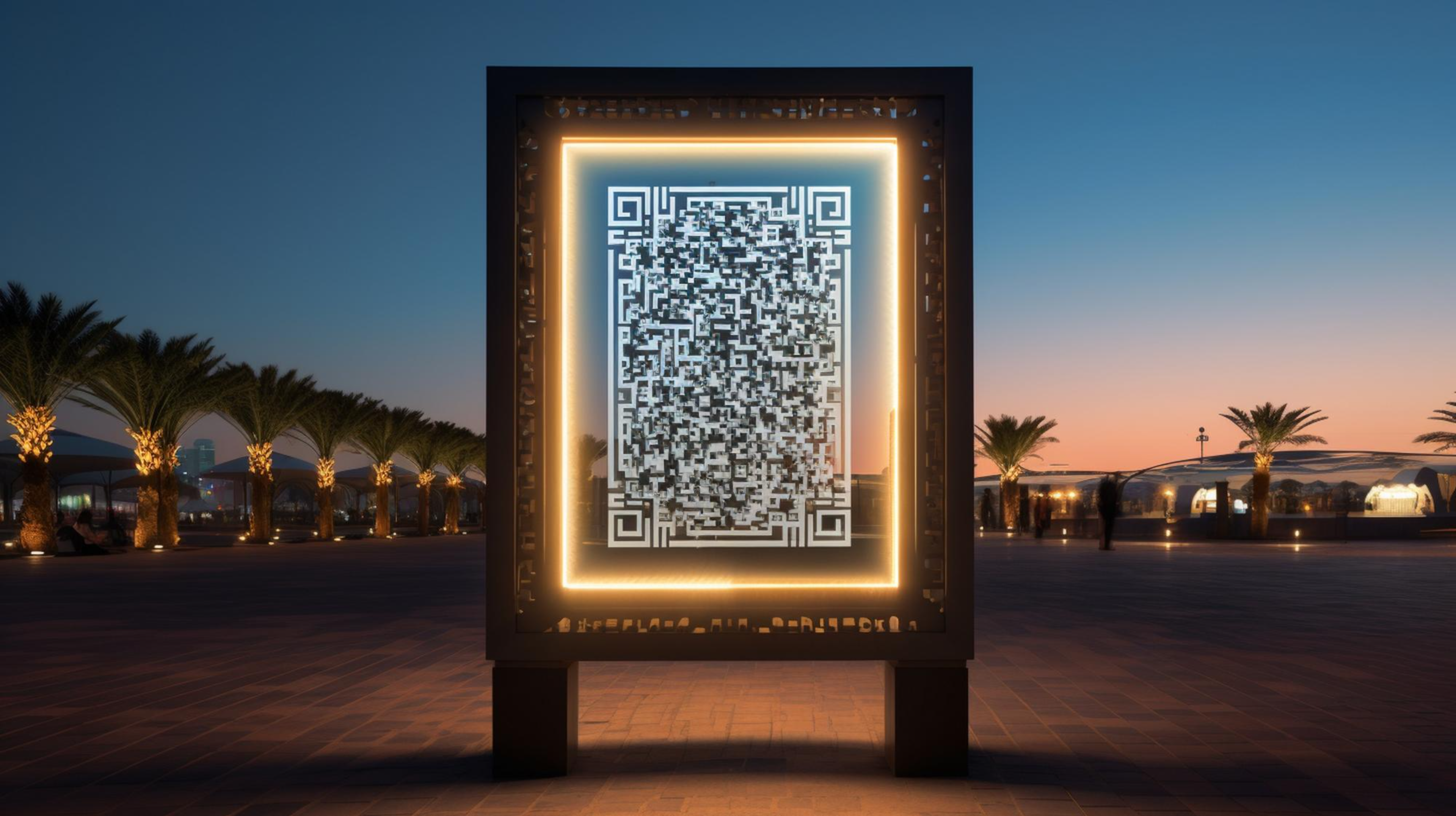
Digital signage replaces those static posters and billboards with dynamic, digital displays. These displays use various technologies like LCD, LED, or projection to showcase content that can change in the blink of an eye. This content can range from simple text and images to captivating videos, interactive displays, and even live data streams.
How Does It Work?
At its core, a digital signage system has three main parts:
- The Displays: These are the actual screens you see in shops, stadiums, or airports. They come in all shapes and sizes, from small menu boards to massive video walls.
- The Media Players: These are small, behind-the-scenes devices that power the content. They connect to the displays and store the videos, images, and other assets.
- Content Management System (CMS): This is the software heart of the operation. The CMS lets you create playlists, schedule updates, and manage your displays from a centralized location – even across multiple sites.
Types of Digital Signage
The flexibility of digital signage opens up a world of possibilities:
- Informational Displays: Think airport flight schedules, hospital wayfinding maps, or university campus directories. These displays deliver timely and critical information to the public.
- Advertising: From in-store promotions to giant billboards in Times Square, digital signage offers an eye-catching and dynamic medium for advertisers.
- Interactive: Touchscreens, kiosks, and gesture-controlled displays transform signage into a two-way street. Customers can get personalized information, order products, or provide feedback – all through the screen.
- Internal Communication Displays: Enhance employee engagement and communication within offices, factories, and corporate campuses with real-time announcements, performance metrics, or company news.
The Process (Simplified)
- Content Creation: Design graphics, and videos, or develop interactive elements using design tools or specialized software (like CrownTV offers).
- Upload & Scheduling: Load your content into the CMS (like CrownTV offers a versatile dashboard) and schedule when and where specific pieces should play. With CrownTV, you can schedule all you digital signage screens and manage the schedule according to your business needs.

- Distribution: The CMS pushes the right content to the right screens at the right time.
- Management & Updates: Remotely monitor your displays, troubleshoot issues, and make instant changes to your content from anywhere with internet access.
Let’s move on to the exciting advantages of digital signage.
The Pros of Digital Signage
Let’s talk about why digital signage is taking the modern advertising world by storm:
- Attention-Grabbing and Memorable: Dynamic visuals, motion graphics, and videos naturally draw the eye. Plus, studies show that digital signage has a 47.7% effectiveness on brand awareness and captures 400% more views than static displays. This staying power means 70% of Americans have seen a digital display in the past month, with 52% seeing one in the past week.
- Dynamic and Flexible: Change promotions on the fly, update announcements instantly, or target content based on the time of day, location, or audience behavior. Forget the hassle of reprinting or manually updating old signage – digital keeps you agile.
- Improved Engagement and Impact: Digital signage isn’t just about advertising. It can significantly impact internal communications and workplace metrics – talk about the power of effective communication.
- Enhanced Interactivity: Touchscreens, sensors, and even QR codes turn signs into immersive experiences. Customers can browse menus, explore product details, or even provide feedback right on the spot.
- Data and Analytics: Gather valuable insights into how your content performs. Metrics like audience dwell time, number of impressions, and interaction rates help you measure the true ROI of your signage campaigns.
- Centralized Management: Easily manage a whole network of displays, regardless of location. This is a game-changer for businesses with multiple branches or franchises. Push updates, change schedules, and ensure brand consistency across every screen.
- Scalability: Adding more screens to your network as your business grows is far simpler with digital signage. Unlike traditional methods, expanding your digital signage campaign doesn’t mean starting from zero.
- Potentially Eco-Friendlier: With less wasted paper and reduced printing needs, digital signage can be a greener option. Consider displays with low power consumption and opt for cloud-based CMS solutions to further reduce your footprint.
Case Study: Telecommunications giant Bouygues Telecom partnered with CrownTV to streamline customer experience and communication in their retail stores. Digital signage reduced wait times, enhanced promotion visibility, and boosted customer satisfaction scores across their network of stores.
Digital signage is here to stay – the global market reached $21.59 billion in 2024, and forecasts project a value of almost $33 billion in 2023. This steady growth reflects the increasing adoption and effectiveness of digital signage across industries.
The Cons of Digital Signage
While the benefits of digital signage are undeniable, it’s important to weigh the potential downsides before diving in:
- Higher Initial Cost: The price tag for displays, media players, and content management software can outpace the simplicity of a printed sign. It’s crucial to weigh these upfront costs against the long-term benefits that digital signage provides.
- Technical Complexity: Setting up, managing, and troubleshooting digital signage systems does require a certain level of technical know-how. However, many modern solutions, like CrownTV, are designed for user-friendliness, easing this potential hurdle. CrownTV’s dashboard makes it easy for you to navigate your digital signage needs.

- Content is King: Bad, boring, or irrelevant content won’t do you any favors, even on the flashiest screen. Investing time and resources into creating high-quality, engaging content for your screens is essential.
- Potential for Distractions: If done poorly, overly flashy or rapidly changing content can become an annoyance rather than an asset. It’s good to strike a balance between grabbing attention and creating a comfortable viewing experience.
- Security Considerations: Just like any internet-connected device, digital signage systems raise certain cybersecurity concerns. Choosing a reputable provider with strong security protocols and staying vigilant about updates is a must to safeguard your data and LCD screens.
Pro Tip: Remember to factor in the potential costs of maintenance, digital signage software updates, and electricity consumption when calculating the overall ROI of your interactive digital signage investment.
The impact of these drawbacks can vary wildly depending on the scale of your project and your chosen digital signage solution.
The Head-to-Head Battle: Which is Right for Your Business?
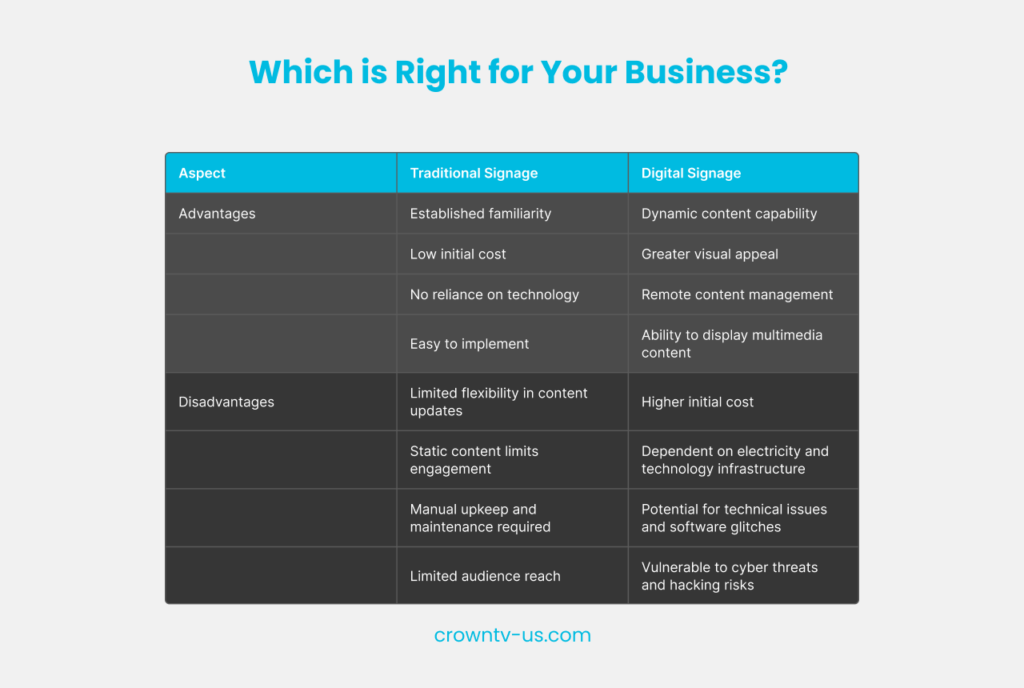
Choosing between traditional and digital signage is rarely a black-and-white decision. The best choice for your business depends on a range of factors. Let’s break it down:
- Budget
- Traditional: Wins for initial investment on small-scale projects. Printing a few posters is cheap.
- Digital: While the upfront cost is higher, digital signage refers to better ROI over the long term due to scalability, flexibility, and measurable results. Consider it an investment in the future.
- Goals
- Traditional: Best when you need a simple, unchanging message for a defined period in a specific location (“Garage Sale This Saturday!”).
- Digital: Excels when you want dynamic content, targeted messaging, audience interactivity, real-time updates, or need to manage multiple electronic displays from a central location.
- Content
- Traditional: Great for simple text, logos, or basic graphics. Changing your content quickly gets cumbersome.
- Digital: The clear winner for videos, animations, eye-catching visuals, scrolling text feeds, and frequently updated information.
- Audience & Targeting
- Traditional: Best for broad, untargeted messages. It catches everyone passing by, whether they’re interested or not.
- Digital: Excels at precise targeting. Change the message based on the time, location, or even viewer demographics – it’s about showing the right message to the right people.
- Measurability
- Traditional: Provides a vague sense of effectiveness, but tracking concrete metrics is tough.
- Digital: Data is its super-power. Track impressions, dwell time, and interactions, and compare digital signage campaigns to optimize your strategy over time.
- Scalability
- Traditional: Each new location means starting from scratch – labor and material costs add up fast.
- Digital: Manage a vast network of screens from a single dashboard. Add locations easily as your business grows.
- Environmental Impact
- Traditional: Higher waste potential due to printing and disposal. Reusing signage can mitigate this.
- Digital: Generally more eco-conscious, especially over the long run, but energy consumption and e-waste should be factored in.
The Hybrid Option
Often, a combination of traditional and digital is the ideal solution. Use signage for unchanging core messages, and digital displays for dynamic elements, promotions, or areas where you need interactivity and data.
Need more help deciding? Get in touch with us, and CrownTV can help create a signage strategy tailored to your needs.
Why Digital Signage Often Outshines Traditional
While there’s a time and place for traditional signage, let’s recap the key areas where digital offers serious advantages that can transform the way you communicate and advertise:
- Grabs Attention in a Crowded World: Moving images, vibrant colors, and dynamic updates help you break through the visual clutter and capture audience interest – static signs simply get lost in the noise.
- Adaptability is Power: The ability to change dynamic and interactive content on the fly is a huge win for businesses. Digital signage keeps your messaging fresh, reacts to trends, and adapts to new sales or initiatives at the speed of modern business.
- The Data Advantage: Knowing how viewers interact with your signage is invaluable. Optimize your messages, tailor digital signage content, and get clear metrics on what’s working – none of this is possible with traditional methods.
- Centralized Control for Consistency and Efficiency: Managing a multi-location campaign becomes surprisingly streamlined with digital signage. Ensure brand consistency, push updates instantly, and scale without increasing complexity.
- Interactivity Turns Viewers Into Participants: Digital turns signage into a two-way conversation. Customers can explore options, get personalized recommendations, or give feedback – transforming the engagement dynamic.
- The Long-Term Win: While the upfront investment might be higher for digital, the flexibility, scalability, and measurable ROI often make it the more cost-effective choice over the lifespan of your campaigns.
The Bottom Line: Digital signage isn’t about replacing traditional signage altogether. Instead, it’s about unlocking new possibilities to better inform, engage, and impress your target audience.
Ready to Upgrade Your Signage Game?
You’ve navigated the world of signs, from classic posters to cutting-edge electronic digital displays. Whether you’re set on digital or see a hybrid approach in your future, remember these key takeaways:
- Content is King: Eye-catching, relevant content always wins, regardless of the medium.
- Target Your Audience: Show the right message to the right people at the right time.
- Data is Your Friend: Leverage analytics (especially with digital) to refine your strategy.
- Consider Scalability: Where do you want your business, and your signage, to be in the future?
If you’re ready to embrace the power, flexibility, and measurable results of digital signage, CrownTV is here to help. Our White Glove service offers expert guidance and a hassle-free experience.
From choosing the perfect hardware and software to content creation and ongoing support, we’ll handle every detail to give you a signage solution that shines. Ready to elevate your visual communication? Get in touch with CrownTV today!
FAQs
What is the difference between signage and digital signage?
- Signage refers to any form of visual communication using signs or displays, both static and dynamic.
- Digital signage is the modern, dynamic upgrade! It uses digital displays (LCD, LED, etc.) to showcase content that can include text, images, videos, animations, and even interactive elements.
What are the cons of traditional signage?
- Limited flexibility: Changing content means reprinting and re-installation.
- No interaction: Traditional signs are a one-way street, lacking customer engagement options.
- Difficult to measure results: Tracking the effectiveness of your signage is more guesswork than science.
- Susceptible to wear and tear: Sunlight, weather, and general use can lead to a shabby, unprofessional look.
What is the difference between digital signage and static signage?
- Static signage is the traditional kind – think posters, billboards, and A-frames. The message doesn’t change without manual intervention.
- Digital signage is dynamic. Content rotates, updates in real-time, and can even be interactive or personalized.
How effective is digital signage?
Extremely. Digital signs offer:
- Increased attention & recall: Studies show viewers are far more likely to notice and remember messages on digital displays compared to static options.
- Measurable results: Track impressions, dwell time, and engagement metrics – optimize your strategy based on data.
- Boosted sales and brand awareness Numerous case studies demonstrate the power of digital signage to drive action and leave a lasting impression.


